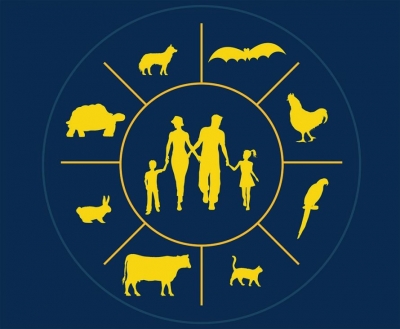
A zoonosis (zoonotic disease or zoonoses -plural) is an infectious disease that is transmitted between species from animals to humans (or from humans to animals). Tiny pathogens that are not visible to the naked eye, can jump from animals to humans causing diseases. With each passing year, World Zoonoses Day, which falls on July 6, gains more relevance. What causes zoonotic diseases? Can they lead to pandemics if left unchecked? Let’s find out…
It was the 1800s. When nine-year-old Joseph Meister was mauled and bit by a dog in 1805. His parents were distraught, for, he had been bitten by a rabid dog. It was a time when rabies spelt a certain terrible death.
In desperation, on the advice of their doctor, Meister’s parents approached a local scientist who was working on a rabies vaccine. He was none other than Louis Pasteur. When young Meister was bought in, the French chemist saw an opportunity to use a human test subject. He had already tested his vaccine on dogs and seen positive results. After consulting fellow scientists, Alfred Vulpian and Jacques-Joseph Grancher, on July 6, 1885, Pasteur administered the vaccine. To everyone’s surprise, the youngster made a full recovery. It is to commemorate Pasteur’s successful administration of the first rabies vaccine that July 6 is celebrated as World Zoonoses Day.
The human-animal connect
So, what is zoonosis? It is an infectious disease that plagues humans, and is usually caused by pathogens that jump from an animal to humans, like, rabies, for instance. The first infected human transmits the infectious agent to at least one other human, who then infects others. The pathogen can be a virus, parasite, bacterium, or prion
Black death
Diseases like the Ebola that wreaked havoc in some parts of Africa, and Nipah that led to health concerns in Kerala in 2018, are examples of zoonoses. While in the early 20th century. HIV was a zoonotic disease, it has now mutated into a human-only disease. Often, many zoonotic viruses recombine with human strains of the flu and can cause pandemics. The 2009 swine flu and the Spanish flu of 1918 are instances of this. An earlier occurrence of this is the plague or the Black Death that ravaged Afro-Eurasia between 1346 to 1353, peaking in Europe from 1347 to1351. Said to have spread from rodents to humans by the bite of infected fleas, it became a searing pandemic, leaving thousands dead in its wake.
Monkey pox
Monkey pox is an ongoing instance of zoonotic disease spread. While the first case in humans was identified in the Democratic Republic of Congo in 1970, earlier this year, it began making an appearance in non-endemic countries too. It is avoidable by restricting contact with infected people or animals, disinfecting frequently touched surfaces, wearing a mask, and sticking to high standards of hygiene.
Major causes
The emergence of such diseases began with the domestication of animals. Simply put, zoonotic transmission can occur when there is a contact with animals or consumption of animals or their products.
According to a United Nations Environment Programme and International Livestock Research Institute report, environmental causes such as climate change. wildlife exploitation and unsustainable agriculture are the prime reasons for the rise in such diseases. Contact with infected farm animals can lead to disease in farmers or others that come in contact with them. For instance, close interaction with infected cattle can lead to anthrax infection. In many cases, different types of food that come from animals can face zoonotic contamination, including seafood, eggs, meat, diary, and so on.
Did you know?
- Sixty percent of all human infectious diseases are considered zoonoses
- One of the largest zoonoses-related threats is food insecurity, due to livestock loss from antimicrobial resistance and disease.
- Eighty percent of agents, that are deemed to have a potential for use in bioterrorism, are zoonotic pathogens. The World Organization for Animal Health encourages strong health monitoring systems for proper surveillance and prevention of zoonotic pathogens from being used as weapons.
- The concentrated effort to study human-animal-environmental interactions is a field known as One Health
- Rinderpest, also known as also cattle plague or steppe murrain was declared as eradicated in 2011.
Picture Credit : Google




